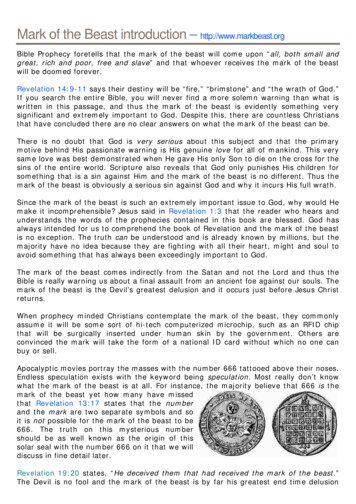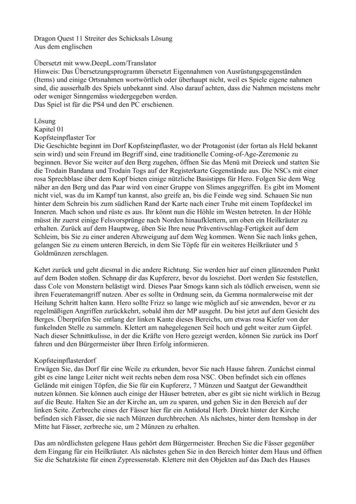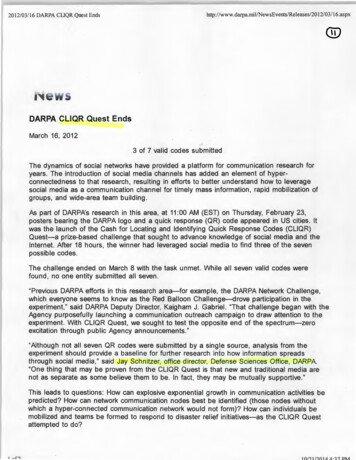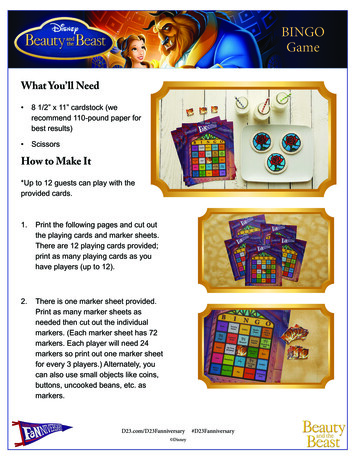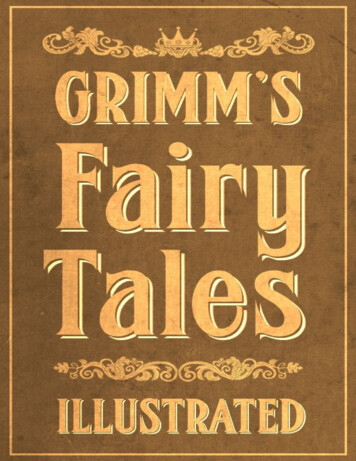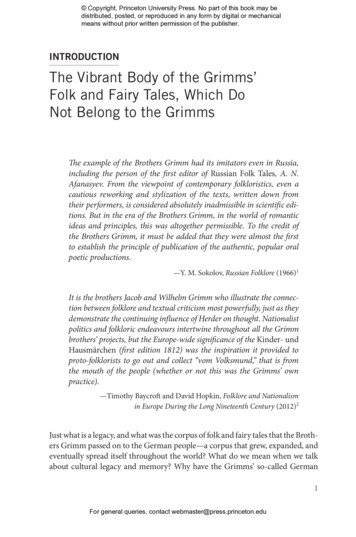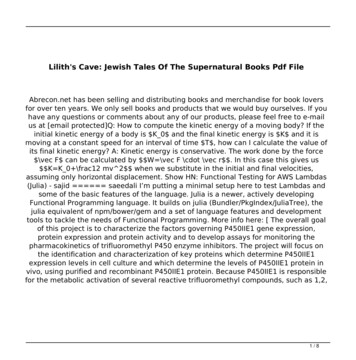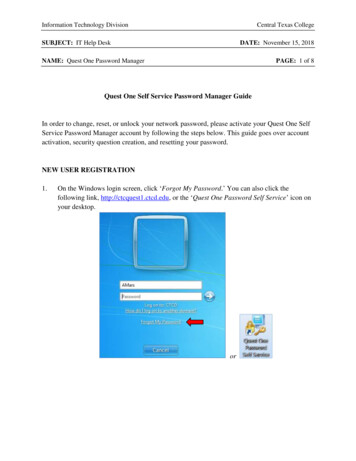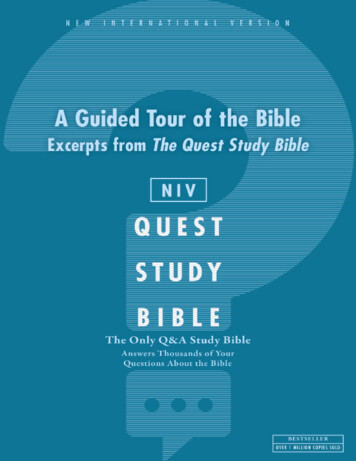
Transcription
Beast Quest Tales of TerrorA National Literacy Trust membership resourceFight the beasts; fear the magicAn addictive and all-engaging journey into the fantasy world of Avantia complete withwizards, heroes, magic and, of course, an array of deadly beasts to overcome! Theever popular Beast Quest books provide a wonderful stimulus for reading and writingin all shapes and forms; narrative, non-fiction, drama and poetry.The first series of books follows the journey of two unlikely heroes – Tom, a seeminglyordinary boy from the village of Errinel, and his new-found friend, the orphan Elenna – in aquest to save the kingdom of Avantia from the Dark Wizard, Malvel.Aided by their trusted companions, a wolf named Silver and Tom’s horse Storm, the twochildren are charged with the unenviable task of freeing the six protectors of the kingdomfrom an evil spell. It just so happens that the protectors, now turned destroyers, are sixterrifying beasts: a sea serpent, mountain giant, horse-man, snow monster, flame bird andthe first beast we are introduced to – Ferno, the Fire Dragon. As Tom and Elenna travelthrough the land of Avantia, we travel with them across the first series of six booksencountering a new beast with all its particular perils and dangers in each. As the questcontinues the Defenders become our friends and we find out more about Tom’s missingfather, Taladon the Swift, the Ancient Scripts of the kingdom and the history between thebattling wizards. It’s an enticing adventure which grips young readers and draws them intothis exciting, addictive and magical world.We start with Tom’s accidental recruitment as a knight for the realm and his first beastchallenge against Ferno the Fire Dragon. The following activities support the introduction ofthe series, concentrating on the first book, and help to immerse and engage pupils in theworld of Avantia through a range of activities to develop reading and writing in context. Joinour Beast Quest Tales of Terror for a whole half-term theme or dip in to the activities asincidental reading and writing opportunities to support writing your own quest.Beginning with the end in mind We know that all good planning starts with knowing where we are going and what we wantto achieve. The perfect narrative outcome for a whole unit, and one pupils naturally movetowards, is writing their own Beast Quest story. Each book follows a familiar plot patternwhich gives an easily replicated structure and allows pupils to use this structure whileputting their imaginative efforts into exploring and creating their own interesting andexciting characters and settings. Knowing from the outset that they will have theopportunity to write their own quest means that all the literacy activities immersing theminto the world of Avantia can be used to feed their imagination and give a richness andpurpose to their reading and writing.All text The National Literacy Trust 2017T: 020 7587 1842 W: www.literacytrust.org.uk Twitter: @Literacy Trust Facebook: nationalliteracytrustThe National Literacy Trust is a registered charity no. 1116260 and a company limited by guarantee no. 5836486 registered in England and Walesand a registered charity in Scotland no. SC042944. Registered address: 68 South Lambeth Road, London SW8 1RL
Exploring structureAs you begin to read Ferno, the Fire Dragon with pupils use the Avantia map to encourageoral retelling of the story as you go along. Pupils can make and illustrate their own storymaps and add details and their own observations along the way, plotting where they thinkTom’s house might be in Errinel or the site of the village square. Being in charge of their owndetailed map also encourages close reading of the book; where the river is, the palacecourtyard, the towering city walls and even smaller details like the larger pillar behind theKing’s chair. Retelling the story in pairs and groups using the maps helps embed the storyand its structure and will help bring the kingdom of Avantia alive. Use the Ferno Story Mountain (see below) to help explore the story structure of thefirst book, using the title chapters as a guide. Encourage pupils to begin to plan and develop their own ideas for a Beast Quest asyou explore the book further. You can use the New Beast Quest Mountain as aplanning guide, which keeps much closer to the original story line while stillencouraging pupils to choose their own beast and settings.Writing opportunities galoreWhilst building to a final narrative outcome at the end of the unit, many opportunities forother forms of writing can be used to engage pupils.Writing in role and rewriting the book’s climax as Tom comes face-to-face with the dragonbut this time from his horse Storm’s perspective, or through the eyes of Silver, the Wolf, is alovely activity.Advert for a hero: Tom, rather by accident (or is it fate?) becomes the chosen one toattempt the quest after Sir Caldor the Brave had already failed. Design an advert for theideal knight; what qualities would King Hugo and Aduro the good wizard want in theirchosen hero to defeat the six beasts?A letter home: Tom must leave his home and his uncle and aunt to pursue the quest forAduro and the King. Unfortunately he is sworn to secrecy about the beasts’ existence andhis journey. He doesn’t want to worry them but he will have to lie to reassure them he iswell. What excuse could he find and what might he write in his letter home?Mystery blaze blasts Errinel: There is a mysterious fire in the fields of the village, no oneknows how it started but rumours abound and legends are discussed. Eyewitnesses thinkthey saw a large shadow in the sky. Ask the children to write a front page news report fromthe Errinel Herald on the day disaster struck. Lots of drama and role play opportunities willarise as you interview the villagers and even Tom himself to explore the panic and perilcreeping into the kingdom.Prequel: At the beginning of the book is a short prologue of Caldor the Brave’s encounterwith the Fire Dragon. Perhaps we could go even further back and write a prequel to thebook when the beasts were in fact protectors of the realm and not the destroyers theybecame, or even the story of how the wizard Malvel turned to his evil ways.Book of Beasts: Aduro has already compiled an amazing Book of Beasts which details beastsfrom across the series of books. Perhaps pupils could go one step further to create a classAll text The National Literacy Trust 2017
encyclopedia or a series of reports with details of all the new beasts they are about toinvent for their own quests. Use the Beast Report Planner (see below) to help structureyour reports.Majestic menu: As Tom enters the palace he is taken through the court kitchens and intothe King’s dining chamber. A long dining table is set with candles. Can pupils imagine whatthe King of Avantia would have on his menu for the evening and design and display itbeautifully?Author facts: With such popularity and profile, pupils may want to find out about theauthor who created Avantia and more beasts than you could ever imagine. Encourage pupilsto research Adam Blade. Get them to use the Beast Quest website biographywww.seaquestbooks.co.uk and further research to create an author fact file and keepadding questions they’d like to ask the author as they progress through the books.Bringing Beast Quest alive: exploringcharactersAs the first story develops we learn more about our brave Defenders and more too aboutthe world they inhabit; the village of Errinel, the Grassy Plains and the Forest of Fear.Cracking characters are the bread and butter of narrative. We want our pupils to exploreand respond to characters through their reading, make connections to the characters theylove (and love to hate) and develop a love of story through their engagement.As Tom and Elenna, our Defenders, are constant throughout the first series it would be goodto introduce ongoing response activities which can develop as pupils work their way throughthe reading challenge.Create a whole class “role on the wall” for each character, even better to use a pupil todraw a full size body outline to display and a basket of post-it notes to encourageannotations, questions and knowledge about the characters to be noted down and collatedas the books are explored. There are many ways to manage the role on the wall, but ourfavourite is to make notes around the body outline to do with factual information we knowfor sure: where they live, appearance, family etc. and inside the character make notes abouttheir personality and character traits of which we learn more and more as we discover moreabout them. Use a specific colour of post-it for questions pupils would like to ask thecharacter.Use emotion graphs to track how Tom and Elenna are feeling throughout each book. Whenare they the closest friends? When are they feeling brave, feeling scared, feeling lonely andhomesick?Drama and role play techniques are often the best way of exploring character and puttingourselves in the character’s shoes. Pick an important scene such as when Tom first entersthe City and sneaks into the King’s dining chamber. Get pupils to read closely and carefullyto recreate a freeze frame of the scene as described in the book, ask for improvised actionthen freeze frame at the moment Tom is discovered and thought-track the main characters.All text The National Literacy Trust 2017
Try drawing comparisons and visualisation activities. Imagine the moment Tom climbsonto the Dragon’s head to try to grab his magical collar; take pupils into the hall and draw ahuge dragon’s head on the floor. As pupils take turns to stand on the image they canimagine what Tom felt like, such a small boy clinging to the head of a Fire Dragon.Naming characters. As pupils begin to plan and create their own characters for their ownquests, encourage them to use techniques like Adam Blade such as naming the characterswith their traits; Caldor the Brave, Taladon the Swift.Art and model-making are also wonderful tools to help bring characters alive. The beasts ofcourse are very important characters in each book. If pupils find it hard to imagine whatFerno is like, scour the character descriptions in the book to build a picture of his head, hisscales, his body, his eyes and use visual literacy to expand pupils’ knowledge and experienceof dragons: a trailer from The Hobbit: The Desolation of Smaug; a class reading of theintroduction of the Space Bat Angel Dragon from The Iron Man. Then encourage pupils todraw or model-make from the details they have collected. As pupils plan and create theirown beast, art and model-making are a perfect way to consolidate their ideas to informtheir descriptive writing.Don’t forget your poetry. To help expand ideas, explore and write short poems aboutbeasts and dragons. The Troll by Jack Prelutsky is a super beast poem and Nick Toczek’sexcellent collection of Dragon Poems work really well to read and perform, then use asmodels to rewrite.Bringing Avantia alive: exploring settingsPart of the reason pupils love this series of books is that they are drawn into the world ofAvantia as Tom and Elenna explore the kingdom through their journey. We move fromforest settings to mountains, plains, rivers and ice lands. As pupils plan their own BeastQuest stories they can use the rich variety of settings in Avantia to help plan their ownjourneys through dangerous lands.Encourage pupils to design a new map of their own, plotting the journey of their ownDefenders to find a beast, referring back to their story plans (New Beast Quest Mountain).The more detail and time spent creating their journeys, the better prepared they will be towrite their own quest. So have some fun, age your maps or even make them fromparchment paper. Explore other map examples; from Treasure Island or even theMarauder’s Map from Harry Potter – magical just like Tom’s map from Aduro!Get pupils to name their created locations using abstract nouns like the Forest of Fear. Howabout the Woods of Terror or the Desert of Desolation (a little alliteration adds that extrahook!). Or go even further and explore personification with the Wailing Woods or theMoaning Mountains.Poetry again is a great way to build a vivid image of a location. First, try a drama soundscapeactivity (see http://dramaresource.com/strategies/soundscape) for an excellent examplealong with lots of other super drama activities). Then move on to a short senses poem. TheSound Collector by Roger McGough is a great model to use as a starting point to create newpoems full of the sounds that pupils might find in particular settings.All text The National Literacy Trust 2017
The three ‘P’s of storytelling should now be in place; people, places and problems. Pupils,now immersed, can go on to create their own Beast Quest stories. Providing book-makingtemplates and allowing time for illustration and publishing will help motivate pupils andmake their Beast Quest adventure one they will never forget.Further fun across the curriculum Use the Avantia map to create a grid map and practice co-ordinates and compass work.Or create your own version of the game Battleships but trying to locate beasts instead. Combine science and design & technology in creating a moving beast complete withglowing bulb eyes or moving parts with links and levers. The Avantia map could be used to help explore human and physical features ingeography. In PE use positional language or the language of turns, half turns, etc. to direct pupilsaround an Avantian obstacle course. Create a class competition ladder for a Beast Quest Tournament. Who can get thehighest scores? Challenge pupils to create their own version of Top Trumps using the beasts they havecreated; age, power, magical level and fright factorAll text The National Literacy Trust 2017
Climax6. The Forestof Fear7. Dawn of theDragon5. GatheringStormBuild Up4. A Quest8. Final Combat3. The King’s Court2. Journey to the CityEndingOpening1. The Mysterious FireAll text The National Literacy Trust 20179. TheBeginning
3. First Peril / First Task-Choose an interesting setting on the journey?-What obstacle must the defenders overcome?-Can you introduce a magical weapon?-Perhaps another companion joins?-Where next on the map?-We find out more about the BeastClimax4. Meeting the Beast-Choose a new and dangerous setting-How do the Defenders find the Beast - or does theBeast find them?!-Get the companions involved.-The Beast shows his evil powersBuild UpResolution2. Defender sets out on the quest-Why is he / she chosen?-Does someone help /give advice/ a map?-What about a companion/ helper?Defender meets an ally- How do they meet?-Where do they meet?5. Defeating the Beast-The Defenders work together-Do they have extra help? Perhaps magical?-Is the Beast killed or is it released from an evilspell and becomes good?-Are there any other casualties?OpeningEnding1. Introduce your Defender- Where do they live?- Do they have a family?- What are they like?Introduce your Beast.- What chaos is it causing?- How does your hero learn about it?All text The National Literacy Trust 2017Story Mountain6. Where next ?-Is the Defenders’ work complete?-How have they changed?-Are new friendships / new powers found?-Can you introduce their next journey andchallenge?
Climax6. The Forest of Fear7. Dawn of the Dragon5. Gathering StormBuild Up4. A Quest8. Final Combat3. The King’s Court2. Journey to the CityEndingOpening1. The Mysterious FireAll text The National Literacy Trust 20179. The Beginning
Outline plan for a Beast Quest reportFact fileExampleName:FernoTitle:The Fire DragonAppearance:coal-black head, jagged wings,slate-like scales .Dwelling place:a cave in The NorthernMountainsSecret skills:ability to hypnotize, lethalwhipping tail, breathes fire .Magic powers:can turn invisibleDiet:sheep, foxes, small humans!Charactertraits:generally bad tempered, easilyannoyedWorst deed todate:eating Caldor the BraveAll text The National Literacy Trust 2017Notes
the first beast we are introduced to - Ferno, the Fire Dragon. As Tom and Elenna travel through the land of Avantia, we travel with them across the first series of six books encountering a new beast with all its particular perils and dangers in each. As the quest continues the Defenders become our friends and we find out more about Tom's .
